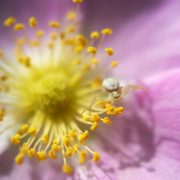By Dr. Tom Chapman, Memorial University
—-
I used scissor to cut my pant into short. A jarring opening sentence, I know. It is how I use to feel when someone dropped the “s” in “thrips”; it is a plural noun, don’t you know? If you see a solitary individual of these animals it is still referred to as a “thrips”. I have been quick to correct people that have made this mistake. But lately on this issue, I have become tired of being the grammar pedant.
I don’t mean to be insulting to the readers of this blog, I am assuming you are knowledgeable and enthusiastic about insects, but just maybe you haven’t heard much of thrips. They are members of the insect Order Thysanoptera, and world wide there are at least 5000 species. They are small; in fact, they are typically the size and colour of the commas in this very sentence. These slithering punctuation marks do not commonly attract the attention of insect enthusiasts. However, for a small number of economically important species there is a large and vibrant community of researchers. These scientists routinely gather together to describe and discuss their research outcomes, with their next big event to be held in California (2015, Xth International Symposium on Thysanoptera & Tospoviruses). Among the dominant applied work that will be presented at this meeting, and those of the past nine meetings, will also be more curiosity driven research. This group of non-applied thrips-focused researchers could book a table at most restaurants. No more or less important, just a more private club. A club I joined as a PhD student.
Professor Bernard Crespi, in his early career, did a stint in Australia as a Research Associate. His motivation to travel to the antipodes was to answer the challenge, are there social thrips? The evolution of altruism (sub-fertility in part of a population) in the insects was and remains an outstanding conundrum for evolutionary theory. Theoretical attempts made in the sixties and seventies to explain these incidences of self-sacrificing castes appeared to also predict that somewhere within the diversity of thrips species we should also find sociality. There were no ready examples. Crespi had a hunch that social thrips would be found among the gall-inducing thrips on Australian Acacia. In brief, he was right! Subsequently (Again, drastically shortening the story. Hey, I am not trying to write Crespi’s biography here.), Crespi took a position at Simon Fraser University where his research began with a focus on Australian social thrips. I was the first graduate student he recruited.
I will admit that the thrips played no part in attracting me to the program. Instead, it was Crespi’s strong scientific reputation and the chance to do field work in Australia that was the lure. However, it was several years of working in Canada with preserved and frozen specimens of thrips before I saw their full charm in their native habitat. I was hosted in Australia by Crespi’s major collaborator with the thrips work, Dr. Michael Schwarz, at Flinders University. In this prominent social insect lab I met three students with the same taxonomic focus as me. Like Tigger in The Tigger Movie, I had started to fear that I was the only one. We connected quickly, and one of the pivotal bonding events happened during a trip to a Nursery outside the city of Adelaide. We needed native Australian plants for an experiment and the Nursery that could provide them was located inside a national park. On the way in we saw a sign warning visitors that they were not permitted to bring in plants or soil for fear of introducing pests. The list of pests included “thrip”. On our way out of the park, we stopped our truck; one of us jumped out with a permanent marker and added an “s”. Having scored one for thrips, we cheered and drove away.
It has been almost twenty years since we vandalized that sign (I hope that is longer then the crime’s statute of limitation). Since then I have continued research on social thrips, and I have given lectures in undergraduate and graduate classes, job interviews, conferences, public lectures and even dinner parties. Many people have engaged me after these events to express further interest in the work. If they said “thrip”, I corrected them. I thought educating people outweighed the potential risk of embarrassing them. My behaviour has certainly lost me a few acquaintances, some people have skin that is thin, but is there any evidence that I have been successful in educating people? I think the answer is no. A student of mine was interviewed a little while ago on the national radio science show, Quirks and Quarks. She corrected the host when he dropped the “s”. Two students and I submitted a paper to an entomological journal, and one reviewer pointed out to the editor the poor grammar of our presentation. The example they used to illustrate our incompetence was our failure to drop the “s”. I am co-writing a book chapter with a longtime friend and colleague, he edited my part by dropping a few of the “s”s. I give up. Not research or a fascination with thrips, just the “s” thing. It is now my opinion that the thrips research community is better off without this plural noun. To the uninitiated it sounds weird to use “thrips” in the singular, and to insist on its proper use is alienating. I don’t know how to change this. Who is in charge? How do you start a revolution? In the mean time, to those that naturally say “thrip” I am sorry I have offended you, let’s be friends.


